Linux高并发服务器之Linux多线程开发
本文源自C++高薪面试项目的学习笔记,主要记录Liunx多线程的学习,主要知识点是线程概述等基础概念以外,还有线程相关Liunx系统函数以及对应练手代码,除此之外还有线程同步问题的讲解以及实战多线程买票问题及解决,并且使用互斥锁、读写锁等方法解决的生产者和消费者模型,最后就是有关死锁问题的概念,以及采用银行家算法等对死锁问题的处理
一、线程概述
与进程(process)类似,线程(thread)是允许应用程序并发执行多个任务的一种机制。一个进程可以包含多个线程。同一个程序中的所有线程均会独立执行相同程序,且共享同一份全局内存区域,其中包括初始化数据段、未初始化数据段,以及堆内存段。(传统意义上的 UNIX 进程只是多线程程序的一个特例,该进程只包含一个线程)
- 进程是 CPU 分配资源的最小单位,线程是操作系统调度执行的最小单位。
- 线程是轻量级的进程(LWP:Light Weight Process),在 Linux 环境下线程的本质仍是进程。
- 查看指定进程的 LWP 号:
ps –Lf pid - man找不到有关rwlock等函数可以
sudo apt-get install manpages-posix-dev
进程和线程的区别:
? 进程间的信息难以共享。由于除去只读代码段外,父子进程并未共享内存,因此必须采用
一些进程间通信方式,在进程间进行信息交换。
? 调用 fork() 来创建进程的代价相对较高,即便利用写时复制技术,仍然需要复制诸如
内存页表和文件描述符表之类的多种进程属性,这意味着 fork() 调用在时间上的开销
依然不菲。
? 线程之间能够方便、快速地共享信息。只需将数据复制到共享(全局或堆)变量中即可。
? 创建线程比创建进程通常要快 10 倍甚至更多。线程间是共享虚拟地址空间的,无需采
用写时复制来复制内存,也无需复制页表
进程和线程虚拟地址空间:
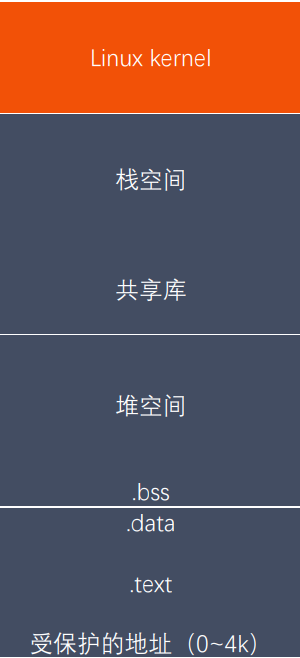
线程之间共享和非共享的资源:
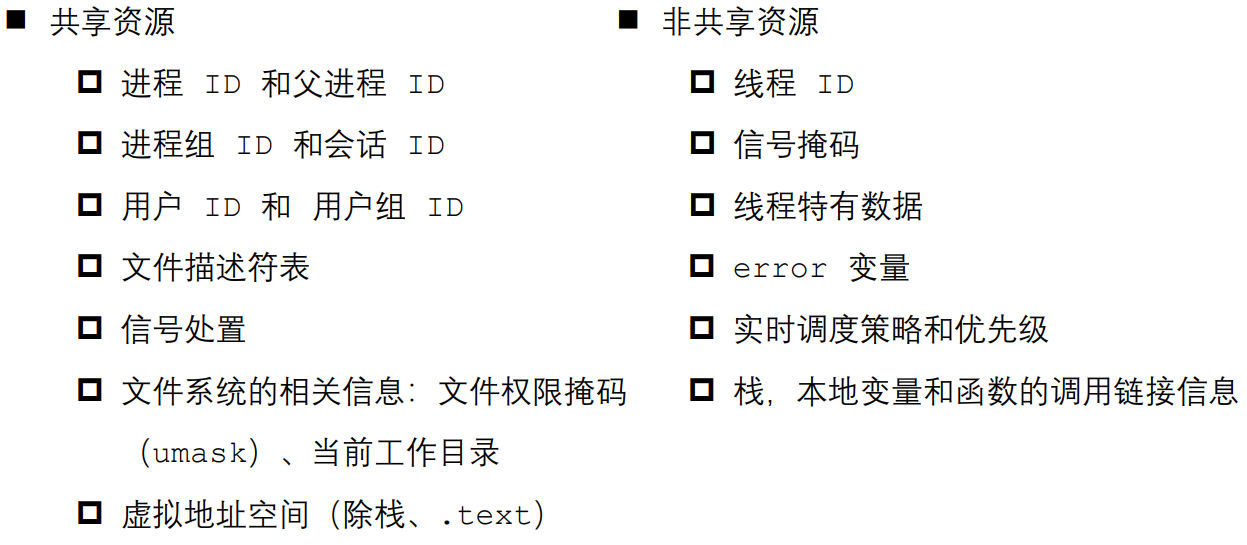
Liunx线程库--NPTL:
? 当 Linux 最初开发时,在内核中并不能真正支持线程。但是它的确可以通过 clone()
系统调用将进程作为可调度的实体。这个调用创建了调用进程(calling process)的
一个拷贝,这个拷贝与调用进程共享相同的地址空间。LinuxThreads 项目使用这个调用
来完成在用户空间模拟对线程的支持。不幸的是,这种方法有一些缺点,尤其是在信号处
理、调度和进程间同步等方面都存在问题。另外,这个线程模型也不符合 POSIX 的要求。
? 要改进 LinuxThreads,需要内核的支持,并且重写线程库。有两个相互竞争的项目开始
来满足这些要求。一个包括 IBM 的开发人员的团队开展了 NGPT(Next-Generation
POSIX Threads)项目。同时,Red Hat 的一些开发人员开展了 NPTL 项目。NGPT
在 2003 年中期被放弃了,把这个领域完全留给了 NPTL。
? NPTL,或称为 Native POSIX Thread Library,是 Linux 线程的一个新实现,它
克服了 LinuxThreads 的缺点,同时也符合 POSIX 的需求。与 LinuxThreads 相
比,它在性能和稳定性方面都提供了重大的改进。
? 查看当前 pthread 库版本:getconf GNU_LIBPTHREAD_VERSION
二、线程操作相关函数
查看线程相关所有函数:man -k pthread 或者man pthread加上两次tap键
注意编译要加上 -pthread:gcc test.c -o app -pthread
相关函数如下:
? int pthread_create(pthread_t *thread, const pthread_attr_t *attr,
void (start_routine) (void *), void *arg); // 创建子线程
? pthread_t pthread_self(void); //获取当前线程id
? int pthread_equal(pthread_t t1, pthread_t t2); //比较两线程id是否相等
? void pthread_exit(void *retval);//退出当前线程
? int pthread_join(pthread_t thread, void **retval);//连接已终止的子线程回收资源
? int pthread_detach(pthread_t thread); //分离线程,进程结束时系统回收其资源
? int pthread_cancel(pthread_t thread); //当线程执行到取消点时终止线程
以上函数逐个介绍并附实操代码如下(多数为老师课上敲的正确代码,如有错漏欢迎指出):
1、创建线程
man pthread_create 查看得以下信息:
#include <pthread.h>
int pthread_create(pthread_t *thread, const pthread_attr_t *attr,
void *(*start_routine) (void *), void *arg);
- 功能:创建一个子线程
- 参数:
- thread: 传出参数,线程创建成功后,子线程的线程ID被写到该变量中。
- attr : 设置线程的属性,一般使用默认值,NULL
- start_routine : 函数指针,这个函数是子线程需要处理的逻辑代码
- arg : 给第三个参数使用,传参
- 返回值:
成功:0
失败:返回错误号。这个错误号和之前errno不太一样。
获取错误号的信息: char * strerror(int errnum);
实操调用:
#include <stdio.h>
#include <pthread.h>
#include <string.h>
#include <unistd.h>
void *callback(void * arg){
int num = *(int *)arg;//需要先将void* 转化为int* 然后再解引用
while(num--){
sleep(1);
printf("child_pthread : %d\n", num);
}
return NULL;
}
int main(){
pthread_t pid;
int num = 999;
int ret = pthread_create(&pid, NULL, callback, (void *)&num);//创建一个子线程
if (ret != 0){ //返回值非0,返回错误信息
char *errstr = strerror(ret);
printf("error: %s\n",errstr);
}
for(int i = 999; i > 0; i++) {
sleep(1); //防止子线程没时间抢占cpu运行
printf("mian_pthread : %d\n", i);
}
return 0;//相当于 exit(0) 进程结束
}
2、线程终止
man pthread_exit 、 man pthread_self 、 man pthread_equal 得出以下信息:
#include <pthread.h>
void pthread_exit(void *retval);
功能:终止一个线程,在哪个线程中调用,就表示终止哪个线程
参数:
retval:需要传递一个指针,作为一个返回值,可以在pthread_join()中获取到。
pthread_t pthread_self(void);
功能:获取当前的线程的线程ID
int pthread_equal(pthread_t t1, pthread_t t2);
功能:比较两个线程ID是否相等
不同的操作系统,pthread_t类型的实现不一样,有的是无符号的长整型,有的
是使用结构体去实现的。
实操调用:
#include <stdio.h>
#include <pthread.h>
#include <string.h>
void * callback(void * arg) {
printf("child thread id : %ld\n", pthread_self());
return NULL; // 相当于 pthread_exit(NULL);
}
int main() {
pthread_t tid;
int ret = pthread_create(&tid, NULL, callback, NULL);// 创建一个子线程
if(ret != 0) {
char * errstr = strerror(ret);
printf("error : %s\n", errstr);
}
// 主线程
for(int i = 0; i < 9; i++) {
printf("%d\n", i);
}
printf("tid : %ld, main thread id : %ld\n", tid ,pthread_self());
// 让主线程退出,当主线程退出时,不会影响其他正常运行的线程。
pthread_exit(NULL);
printf("main thread exit\n");
//当所有子线程都退出后,主进程结束,系统回收所有资源
return 0; // exit(0);
}
3、线程连接
#include <pthread.h>
int pthread_join(pthread_t thread, void **retval);
- 功能:和一个已经终止的线程进行连接
回收子线程的资源
这个函数是阻塞函数,调用一次只能回收一个子线程
一般在主线程中使用
- 参数:
- thread:需要回收的子线程的ID
- retval: 接收子线程退出时的返回值
- 返回值:
0 : 成功
非0 : 失败,返回的错误号
实操演示:
#include <stdio.h>
#include <pthread.h>
#include <string.h>
#include <unistd.h>
int value = 10;
void * callback(void * arg) {
printf("child thread id : %ld\n", pthread_self());
// sleep(3);
// return NULL;
// int value = 10; // 局部变量
pthread_exit((void *)&value); // return (void *)&value;
}
int main() {
// 创建一个子线程
pthread_t tid;
int ret = pthread_create(&tid, NULL, callback, NULL);
if(ret != 0) {
char * errstr = strerror(ret);
printf("error : %s\n", errstr);
}
// 主线程
for(int i = 0; i < 5; i++) {
printf("%d\n", i);
}
printf("tid : %ld, main thread id : %ld\n", tid ,pthread_self());
// 主线程调用pthread_join()回收子线程的资源
int * thread_retval;
ret = pthread_join(tid, (void **)&thread_retval);
if(ret != 0) {
char * errstr = strerror(ret);
printf("error : %s\n", errstr);
}
printf("exit data : %d\n", *thread_retval);
printf("回收子线程资源成功!\n");
// 让主线程退出,当主线程退出时,不会影响其他正常运行的线程。
pthread_exit(NULL);
return 0;
}
4、线程分离
/*
#include <pthread.h>
int pthread_detach(pthread_t thread);
- 功能:分离一个线程。被分离的线程在终止的时候,会自动释放资源返回给系统。
1.不能多次分离,会产生不可预料的行为。
2.不能去连接一个已经分离的线程,会报错。
- 参数:需要分离的线程的ID
- 返回值:
成功:0
失败:返回错误号
*/
#include <stdio.h>
#include <pthread.h>
#include <string.h>
#include <unistd.h>
void * callback(void * arg) {
printf("chid thread id : %ld\n", pthread_self());
return NULL;
}
int main() {
// 创建一个子线程
pthread_t tid;
int ret = pthread_create(&tid, NULL, callback, NULL);
if(ret != 0) {
char * errstr = strerror(ret);
printf("error1 : %s\n", errstr);
}
// 输出主线程和子线程的id
printf("tid : %ld, main thread id : %ld\n", tid, pthread_self());
// 设置子线程分离,子线程分离后,子线程结束时对应的资源就不需要主线程释放
ret = pthread_detach(tid);
if(ret != 0) {
char * errstr = strerror(ret);
printf("error2 : %s\n", errstr);
}
pthread_exit(NULL);
return 0;
}
5、线程取消
/*
#include <pthread.h>
int pthread_cancel(pthread_t thread);
- 功能:取消线程(让线程终止)
取消某个线程,可以终止某个线程的运行,
但是并不是立马终止,而是当子线程执行到一个取消点,线程才会终止。
取消点:系统规定好的一些系统调用,我们可以粗略的理解为从用户区到内核区的切换,这个位置称之为取消点。
*/
#include <stdio.h>
#include <pthread.h>
#include <string.h>
#include <unistd.h>
void * callback(void * arg) {
printf("chid thread id : %ld\n", pthread_self());
for(int i = 0; i < 5; i++) {
printf("child : %d\n", i);
}
return NULL;
}
int main() {
// 创建一个子线程
pthread_t tid;
int ret = pthread_create(&tid, NULL, callback, NULL);
if(ret != 0) {
char * errstr = strerror(ret);
printf("error1 : %s\n", errstr);
}
// 取消线程
pthread_cancel(tid);
for(int i = 0; i < 5; i++) {
printf("%d\n", i);
}
// 输出主线程和子线程的id
printf("tid : %ld, main thread id : %ld\n", tid, pthread_self());
pthread_exit(NULL);
return 0;
}
6、线程属性
man -k pthread_attr_ :查看所有线程属性函数,或者man pthread_attr_加上两次tap键
线程属性类型 pthread_attr_t
- int pthread_attr_init(pthread_attr_t *attr); // 初始化线程属性变量
- int pthread_attr_destroy(pthread_attr_t *attr); //释放线程属性的资源
- int pthread_attr_getdetachstate(const pthread_attr_t attr, intdetachstate);//获取线程分离的状态属性
- int pthread_attr_setdetachstate(pthread_attr_t *attr, int detachstate);//设置线程分离的状态属性
#include <stdio.h>
#include <pthread.h>
#include <string.h>
#include <unistd.h>
void * callback(void * arg) {
printf("chid thread id : %ld\n", pthread_self());
return NULL;
}
int main() {
// 创建一个线程属性变量
pthread_attr_t attr;
// 初始化属性变量
pthread_attr_init(&attr);
// 设置属性
pthread_attr_setdetachstate(&attr, PTHREAD_CREATE_DETACHED);
// 创建一个子线程
pthread_t tid;
int ret = pthread_create(&tid, &attr, callback, NULL);
if(ret != 0) {
char * errstr = strerror(ret);
printf("error1 : %s\n", errstr);
}
// 获取线程的栈的大小
size_t size;
pthread_attr_getstacksize(&attr, &size);
printf("thread stack size : %ld\n", size);
// 输出主线程和子线程的id
printf("tid : %ld, main thread id : %ld\n", tid, pthread_self());
// 释放线程属性资源
pthread_attr_destroy(&attr);
pthread_exit(NULL);
return 0;
}
Linux默认为每个线程分配了足够的堆栈空间(一般是8MB = 8388608 B),可以用ulimit -s 命令查看或修改这个默认值;
三、线程同步
线程同步:即当有一个线程在对内存进行操作时,其他线程都不可以对这个内存地址进
行操作,直到该线程完成操作,其他线程才能对该内存地址进行操作,而其他线程则处
于等待状态。
线程的主要优势在于,能够通过全局变量来共享信息。不过,这种便捷的共享是有代价的:必须确保多个线程不会同时修改同一变量,或者某一线程不会读取正在由其他线程修改的变量。
? 临界区是指访问某一共享资源的代码片段,并且这段代码的执行应为原子操作,也就是同时访问同一共享资源的其他线程不应中断该片段的执行。
1、多线程卖票案例
使用多线程实现买票的案例。有3个窗口,一共是100张票。
#include <stdio.h>
#include <pthread.h>
#include <unistd.h>
// 全局变量,所有的线程都共享这一份资源。
int tickets = 100;
void * sellticket(void * arg) {
// 卖票
while(tickets > 0) {
usleep(6000);
printf("%ld 正在卖第 %d 张门票\n", pthread_self(), tickets);
tickets--;
}
return NULL;
}
int main() {
// 创建3个子线程
pthread_t tid1, tid2, tid3;
pthread_create(&tid1, NULL, sellticket, NULL);
pthread_create(&tid2, NULL, sellticket, NULL);
pthread_create(&tid3, NULL, sellticket, NULL);
// 回收子线程的资源,阻塞
pthread_join(tid1, NULL);
pthread_join(tid2, NULL);
pthread_join(tid3, NULL);
pthread_exit(NULL); // 退出主线程
return 0;
}
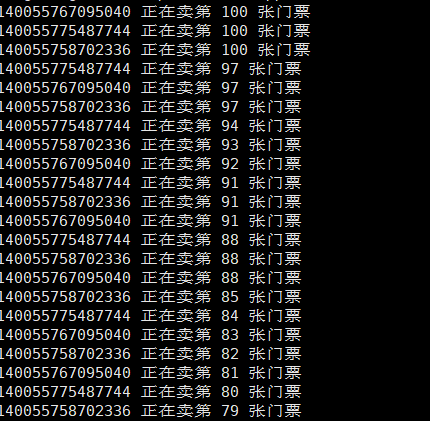
执行以上代码会发现一个问题,一张门票似乎被买了三次?这是因为在当全局变量为100的时候同时被多个子线程读取后造成的问题,解决这个问题有很多方法,比如互斥量
2、互斥锁解决卖票问题
? 为避免线程更新共享变量时出现问题,可以使用互斥量(mutex 是 mutual exclusion的缩写)来确保同时仅有一个线程可以访问某项共享资源。可以使用互斥量来保证对任意共享资源的原子访问。
? 互斥量有两种状态:已锁定(locked)和未锁定(unlocked)。任何时候,至多只有一个线程可以锁定该互斥量。试图对已经锁定的某一互斥量再次加锁,将可能阻塞线程或者报错失败,具体取决于加锁时使用的方法。
? 一旦线程锁定互斥量,随即成为该互斥量的所有者,只有所有者才能给互斥量解锁。一般情况下,对每一共享资源(可能由多个相关变量组成)会使用不同的互斥量,每一线程在访问同一资源时将采用如下协议:
- 针对共享资源锁定互斥量
- 访问共享资源
- 对互斥量解锁
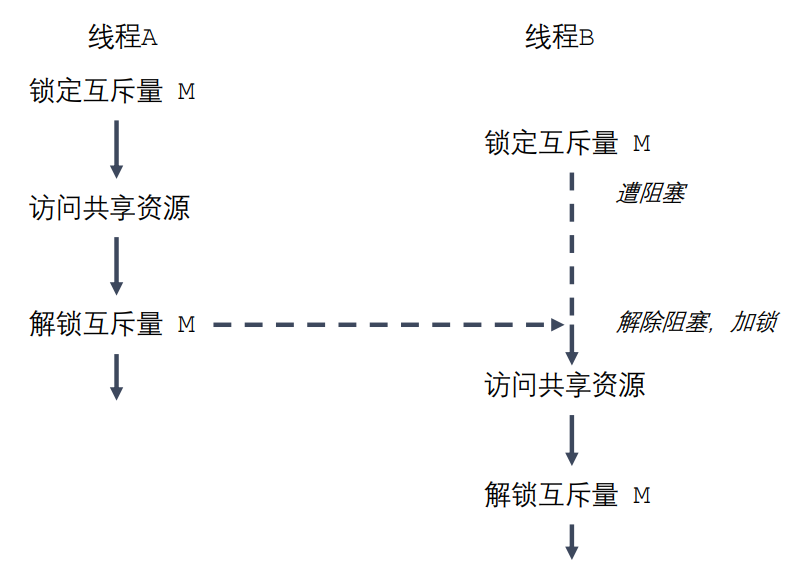
如果在man操作手册中找不到有关mutex,可以尝试命令
sudo apt-get install manpages-posix-dev安装额外帮助包即可
然后 man pthread_mutex_再连续按tap两下即可
互斥量相关函数:
互斥量的类型 pthread_mutex_t
int pthread_mutex_init(pthread_mutex_t *restrict mutex, const pthread_mutexattr_t *restrict attr);
- 初始化互斥量
- 参数 :
- mutex : 需要初始化的互斥量变量
- attr : 互斥量相关的属性,NULL
- restrict : C语言的修饰符,被修饰的指针,不能由另外的一个指针进行操作。
pthread_mutex_t *restrict mutex = xxx;
pthread_mutex_t * mutex1 = mutex;
int pthread_mutex_destroy(pthread_mutex_t *mutex);
- 释放互斥量的资源
int pthread_mutex_lock(pthread_mutex_t *mutex);
- 加锁,阻塞的,如果有一个线程加锁了,那么其他的线程只能阻塞等待
int pthread_mutex_trylock(pthread_mutex_t *mutex);
- 尝试加锁,如果加锁失败,不会阻塞,会直接返回。
int pthread_mutex_unlock(pthread_mutex_t *mutex);
- 解锁
使用互斥锁实操解决卖票问题:
#include <stdio.h>
#include <pthread.h>
#include <unistd.h>
// 全局变量,所有的线程都共享这一份资源。
int tickets = 1000;
// 创建一个互斥量
pthread_mutex_t mutex;
void * sellticket(void * arg) {
// 卖票
while(1) {
// 加锁
pthread_mutex_lock(&mutex);
if(tickets > 0) {
usleep(6000);
printf("%ld 正在卖第 %d 张门票\n", pthread_self(), tickets);
tickets--;
}else {
// 解锁
pthread_mutex_unlock(&mutex);
break;
}
// 解锁
pthread_mutex_unlock(&mutex);
}
return NULL;
}
int main() {
// 初始化互斥量
pthread_mutex_init(&mutex, NULL);
// 创建3个子线程
pthread_t tid1, tid2, tid3;
pthread_create(&tid1, NULL, sellticket, NULL);
pthread_create(&tid2, NULL, sellticket, NULL);
pthread_create(&tid3, NULL, sellticket, NULL);
// 回收子线程的资源,阻塞
pthread_join(tid1, NULL);
pthread_join(tid2, NULL);
pthread_join(tid3, NULL);
pthread_exit(NULL); // 退出主线程
// 释放互斥量资源
pthread_mutex_destroy(&mutex);
return 0;
}
运行以上代码,卖票正常效果如下:
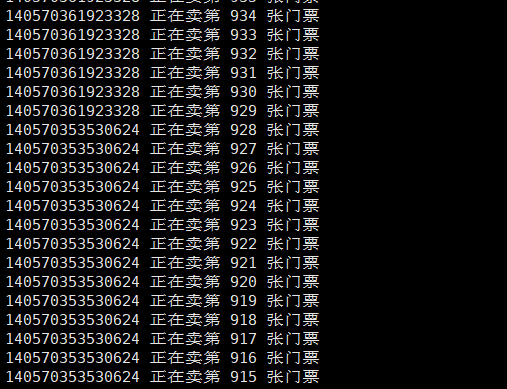
3、读写锁优化卖票问题
当有一个线程已经持有互斥锁时,互斥锁将所有试图进入临界区的线程都阻塞住。但是考虑一种情形,当前持有互斥锁的线程只是要读访问共享资源,而同时有其它几个线程也想读取这个共享资源,但是由于互斥锁的排它性,所有其它线程都无法获取锁,也就无法读访问共享资源了,但是实际上多个线程同时读访问共享资源并不会导致问题。
比如在上述卖票问题中,假设多个窗口的客人都只是查询余票的,也就是只读,如果这个时候如果是使用的互斥锁,那么这些线程都得等着锁的释放,但是这可以优化一下采用读写锁,当一个线程来访问时,如果是读锁且自己也是读操作就可以访问数据,但是不能修改数据,而如果是写锁,那么就只能等待写锁释放;
在对数据的读写操作中,更多的是读操作,写操作较少,例如对数据库数据的读写应用。为了满足当前能够允许多个读出,但只允许一个写入的需求,线程提供了读写锁来实现。
读写锁的特点:
- 如果有其它线程读数据,则允许其它线程执行读操作,但不允许写操作。
- 如果有其它线程写数据,则其它线程都不允许读、写操作。
- 写是独占的,写的优先级高。
如果在man操作手册中找不到有关rwlock,可以尝试命令
sudo apt-get install manpages-posix-dev安装额外帮助包即可
然后 man pthread_rwlock_再连续按tap两下即可
读写锁的类型 pthread_rwlock_t
? int pthread_rwlock_init(pthread_rwlock_t *restrict rwlock, const pthread_rwlockattr_t *restrict attr);
? int pthread_rwlock_destroy(pthread_rwlock_t *rwlock);
? int pthread_rwlock_rdlock(pthread_rwlock_t *rwlock);
? int pthread_rwlock_tryrdlock(pthread_rwlock_t *rwlock);
? int pthread_rwlock_wrlock(pthread_rwlock_t *rwlock);
? int pthread_rwlock_trywrlock(pthread_rwlock_t *rwlock);
? int pthread_rwlock_unlock(pthread_rwlock_t *rwlock);
/*
案例:6个线程操作同一个全局变量。
3个线程不定时写这个全局变量,3个线程不定时的读这个全局变量
*/
#include <stdio.h>
#include <pthread.h>
#include <unistd.h>
// 创建一个共享数据
int tickets = 100;
pthread_rwlock_t rwlock;
void * writeTickets(void * arg) {
while(1) {
pthread_rwlock_wrlock(&rwlock);
if (tickets > 0)
printf("%ld 售出 : %d 号票\n", pthread_self(), tickets--);
else {
pthread_rwlock_unlock(&rwlock);
break;
}
pthread_rwlock_unlock(&rwlock);
usleep(1000);
}
return NULL;
}
void * readTickets(void * arg) {
while(1) {
pthread_rwlock_rdlock(&rwlock);
if (tickets > 0)
printf("%ld 查询余票为 : %d 张\n", pthread_self(), tickets);
else {
pthread_rwlock_unlock(&rwlock);
break;
}
pthread_rwlock_unlock(&rwlock);
usleep(1000);
}
return NULL;
}
int main() {
pthread_rwlock_init(&rwlock, NULL);
// 创建3个写线程,3个读线程
pthread_t wtids[3], rtids[3];
for(int i = 0; i < 3; i++) {
pthread_create(&wtids[i], NULL, writeTickets, NULL);
}
for(int i = 0; i < 3; i++) {
pthread_create(&rtids[i], NULL, readTickets, NULL);
}
// 连接已终止线程回收
for(int i = 0; i < 3; i++) {
pthread_join(wtids[i], NULL);
}
for(int i = 0; i < 3; i++) {
pthread_join(rtids[i], NULL);
}
pthread_rwlock_destroy(&rwlock);
pthread_exit(NULL);
return 0;
}
效果如下,直到售出最后一张票程序终止:
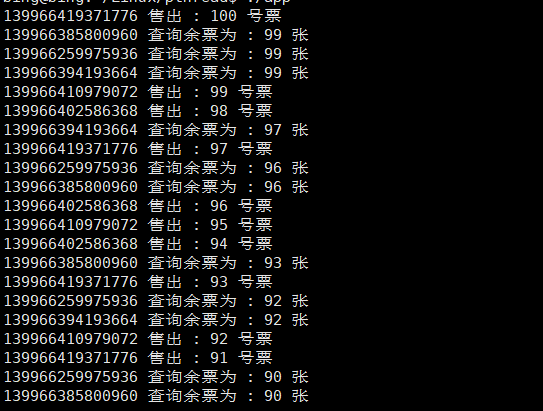
4、生产者消费者模型
/*
生产者消费者模型(粗略的版本)
*/
#include <stdio.h>
#include <pthread.h>
#include <stdlib.h>
#include <unistd.h>
// 创建一个互斥量
pthread_mutex_t mutex;
struct Node{
int num;
struct Node *next;
};
// 头结点
struct Node * head = NULL;
void * producer(void * arg) {
// 不断的创建新的节点,添加到链表中
while(1) {
pthread_mutex_lock(&mutex);
struct Node * newNode = (struct Node *)malloc(sizeof(struct Node));
newNode->next = head;
head = newNode;
newNode->num = rand() % 1000;
printf("add node, num : %d, tid : %ld\n", newNode->num, pthread_self());
pthread_mutex_unlock(&mutex);
usleep(100);
}
return NULL;
}
void * customer(void * arg) {
while(1) {
pthread_mutex_lock(&mutex);
// 保存头结点的指针
struct Node * tmp = head;
// 判断是否有数据
if(head != NULL) {
// 有数据
head = head->next;
printf("del node, num : %d, tid : %ld\n", tmp->num, pthread_self());
free(tmp);
pthread_mutex_unlock(&mutex);
usleep(100);
} else {
// 没有数据
pthread_mutex_unlock(&mutex);
}
}
return NULL;
}
int main() {
pthread_mutex_init(&mutex, NULL);
// 创建5个生产者线程,和5个消费者线程
pthread_t ptids[5], ctids[5];
for(int i = 0; i < 5; i++) {
pthread_create(&ptids[i], NULL, producer, NULL);
pthread_create(&ctids[i], NULL, customer, NULL);
}
for(int i = 0; i < 5; i++) {
pthread_detach(ptids[i]);
pthread_detach(ctids[i]);
}
while(1) {
sleep(10);
}
pthread_mutex_destroy(&mutex);
pthread_exit(NULL);
return 0;
}
5、条件变量解决生产者消费者问题
条件变量的类型 pthread_cond_t
/*
int pthread_cond_init(pthread_cond_t *restrict cond, const pthread_condattr_t *restrict attr);
int pthread_cond_destroy(pthread_cond_t *cond);
int pthread_cond_wait(pthread_cond_t *restrict cond, pthread_mutex_t *restrict mutex);
- 等待,调用了该函数,线程会阻塞。
int pthread_cond_timedwait(pthread_cond_t *restrict cond, pthread_mutex_t *restrict mutex, const struct timespec *restrict abstime);
- 等待多长时间,调用了这个函数,线程会阻塞,直到指定的时间结束。
int pthread_cond_signal(pthread_cond_t *cond);
- 唤醒一个或者多个等待的线程
int pthread_cond_broadcast(pthread_cond_t *cond);
- 唤醒所有的等待的线程
*/
#include <stdio.h>
#include <pthread.h>
#include <stdlib.h>
#include <unistd.h>
// 创建一个互斥量
pthread_mutex_t mutex;
// 创建条件变量
pthread_cond_t cond;
struct Node{
int num;
struct Node *next;
};
// 头结点
struct Node * head = NULL;
void * producer(void * arg) {
// 不断的创建新的节点,添加到链表中
while(1) {
pthread_mutex_lock(&mutex);
struct Node * newNode = (struct Node *)malloc(sizeof(struct Node));
newNode->next = head;
head = newNode;
newNode->num = rand() % 1000;
printf("add node, num : %d, tid : %ld\n", newNode->num, pthread_self());
// 只要生产了一个,就通知消费者消费
pthread_cond_signal(&cond);
pthread_mutex_unlock(&mutex);
usleep(100);
}
return NULL;
}
void * customer(void * arg) {
while(1) {
pthread_mutex_lock(&mutex);
// 保存头结点的指针
struct Node * tmp = head;
// 判断是否有数据
if(head != NULL) {
// 有数据
head = head->next;
printf("del node, num : %d, tid : %ld\n", tmp->num, pthread_self());
free(tmp);
pthread_mutex_unlock(&mutex);
usleep(100);
} else {
// 没有数据,需要等待
// 当这个函数调用阻塞的时候,会对互斥锁进行解锁,当不阻塞的,继续向下执行,会重新加锁。
pthread_cond_wait(&cond, &mutex);
pthread_mutex_unlock(&mutex);
}
}
return NULL;
}
int main() {
pthread_mutex_init(&mutex, NULL);
pthread_cond_init(&cond, NULL);
// 创建5个生产者线程,和5个消费者线程
pthread_t ptids[5], ctids[5];
for(int i = 0; i < 5; i++) {
pthread_create(&ptids[i], NULL, producer, NULL);
pthread_create(&ctids[i], NULL, customer, NULL);
}
for(int i = 0; i < 5; i++) {
pthread_detach(ptids[i]);
pthread_detach(ctids[i]);
}
while(1) {
sleep(10);
}
pthread_mutex_destroy(&mutex);
pthread_cond_destroy(&cond);
pthread_exit(NULL);
return 0;
}
6、信号量解决生产者消费者问题
信号量的类型 sem_t
/*
信号量的类型 sem_t
int sem_init(sem_t *sem, int pshared, unsigned int value);
- 初始化信号量
- 参数:
- sem : 信号量变量的地址
- pshared : 0 用在线程间 ,非0 用在进程间
- value : 信号量中的值
int sem_destroy(sem_t *sem);
- 释放资源
int sem_wait(sem_t *sem);
- 对信号量加锁,调用一次对信号量的值-1,如果值为0,就阻塞
int sem_trywait(sem_t *sem);
int sem_timedwait(sem_t *sem, const struct timespec *abs_timeout);
int sem_post(sem_t *sem);
- 对信号量解锁,调用一次对信号量的值+1
int sem_getvalue(sem_t *sem, int *sval);
sem_t psem;
sem_t csem;
init(psem, 0, 8);
init(csem, 0, 0);
producer() {
sem_wait(&psem);
sem_post(&csem)
}
customer() {
sem_wait(&csem);
sem_post(&psem)
}
*/
#include <stdio.h>
#include <pthread.h>
#include <stdlib.h>
#include <unistd.h>
#include <semaphore.h>
// 创建一个互斥量
pthread_mutex_t mutex;
// 创建两个信号量
sem_t psem;
sem_t csem;
struct Node{
int num;
struct Node *next;
};
// 头结点
struct Node * head = NULL;
void * producer(void * arg) {
// 不断的创建新的节点,添加到链表中
while(1) {
sem_wait(&psem);
pthread_mutex_lock(&mutex);
struct Node * newNode = (struct Node *)malloc(sizeof(struct Node));
newNode->next = head;
head = newNode;
newNode->num = rand() % 1000;
printf("add node, num : %d, tid : %ld\n", newNode->num, pthread_self());
pthread_mutex_unlock(&mutex);
sem_post(&csem);
}
return NULL;
}
void * customer(void * arg) {
while(1) {
sem_wait(&csem);
pthread_mutex_lock(&mutex);
// 保存头结点的指针
struct Node * tmp = head;
head = head->next;
printf("del node, num : %d, tid : %ld\n", tmp->num, pthread_self());
free(tmp);
pthread_mutex_unlock(&mutex);
sem_post(&psem);
}
return NULL;
}
int main() {
pthread_mutex_init(&mutex, NULL);
sem_init(&psem, 0, 8);
sem_init(&csem, 0, 0);
// 创建5个生产者线程,和5个消费者线程
pthread_t ptids[5], ctids[5];
for(int i = 0; i < 5; i++) {
pthread_create(&ptids[i], NULL, producer, NULL);
pthread_create(&ctids[i], NULL, customer, NULL);
}
for(int i = 0; i < 5; i++) {
pthread_join(ptids[i],NULL);
pthread_join(ctids[i],NULL);
}
pthread_mutex_destroy(&mutex);
pthread_exit(NULL);
return 0;
}
四、死锁问题
1、死锁问题的概述
什么是死锁?
两个或两个以上的进程在执行过程中,因争夺共享资源而造成的一种互相等待的现象,若无外力作用,它们都将无法推进下去。此时称系统处于死锁状态或系统产生了死锁。
死锁、饥饿、死循环的区别?
- 死锁是各进程之间互相等待对方的资源,导致各进程都阻塞无法推进的现象;
- 饥饿是某进程长期得不到需要的资源,进程无法推进
- 死循环是进程执行过程中跳不出某个循环的现象,有时是程序逻辑bug有时是程序员故意设计;
区别:
- 死锁、饥饿是操作系分配资源的问题,死循环是代理逻辑错误导致的;
- 饥饿可能是阻塞态也可能是就绪态并且可能是一个或多个,而死锁至少是两个及以上进程同时死锁的,并且一定是阻塞态;
死锁产生的四个必要条件
- 循环等待:存在一种进程资源的循环等待链
- 互斥资源:对互斥的资源的争夺
- 不剥夺条件:即资源只能由进程主动释放,不能被其他进程夺走;
- 请求和保存条件:进程已有一个或多个资源又提出新请求,但是无法获取而阻塞状态
什么时候会发生死锁?
对不可剥夺资源的不合理分配,可能导致死锁。
- 对互斥的系统资源的争夺
- 进程推进顺序非法,a和b并发,分别占1,2,又互相请求对方的资源
- 信号量使用不当,比如生产者消费者问题;或者有时,一个线程需要同时访问两个或更多不同的共享资源,而每个资源又都由不同的互斥量管理。当超过一个线程加锁同一组互斥量时,就有可能发生死锁。
死锁的几种场景:
- 忘记释放锁
- 重复加锁
- 多线程多锁,抢占锁资源
死锁问题代码举例:
#include <stdio.h>
#include <pthread.h>
#include <unistd.h>
// 创建2个互斥量
pthread_mutex_t mutex1, mutex2;
void * workA(void * arg) {
pthread_mutex_lock(&mutex1);
sleep(1);
pthread_mutex_lock(&mutex2);
printf("workA....\n");
pthread_mutex_unlock(&mutex2);
pthread_mutex_unlock(&mutex1);
return NULL;
}
void * workB(void * arg) {
pthread_mutex_lock(&mutex2);
sleep(1);
pthread_mutex_lock(&mutex1);
printf("workB....\n");
pthread_mutex_unlock(&mutex1);
pthread_mutex_unlock(&mutex2);
return NULL;
}
int main() {
// 初始化互斥量
pthread_mutex_init(&mutex1, NULL);
pthread_mutex_init(&mutex2, NULL);
// 创建2个子线程
pthread_t tid1, tid2;
pthread_create(&tid1, NULL, workA, NULL);
pthread_create(&tid2, NULL, workB, NULL);
// 回收子线程资源
pthread_join(tid1, NULL);
pthread_join(tid2, NULL);
// 释放互斥量资源
pthread_mutex_destroy(&mutex1);
pthread_mutex_destroy(&mutex2);
return 0;
}
上述代码sleep是为了产生死锁问题故意的,防止A或B逻辑操作过快无法产生死锁,代码主要是演示死锁问题的产生;
2、死锁问题的处理
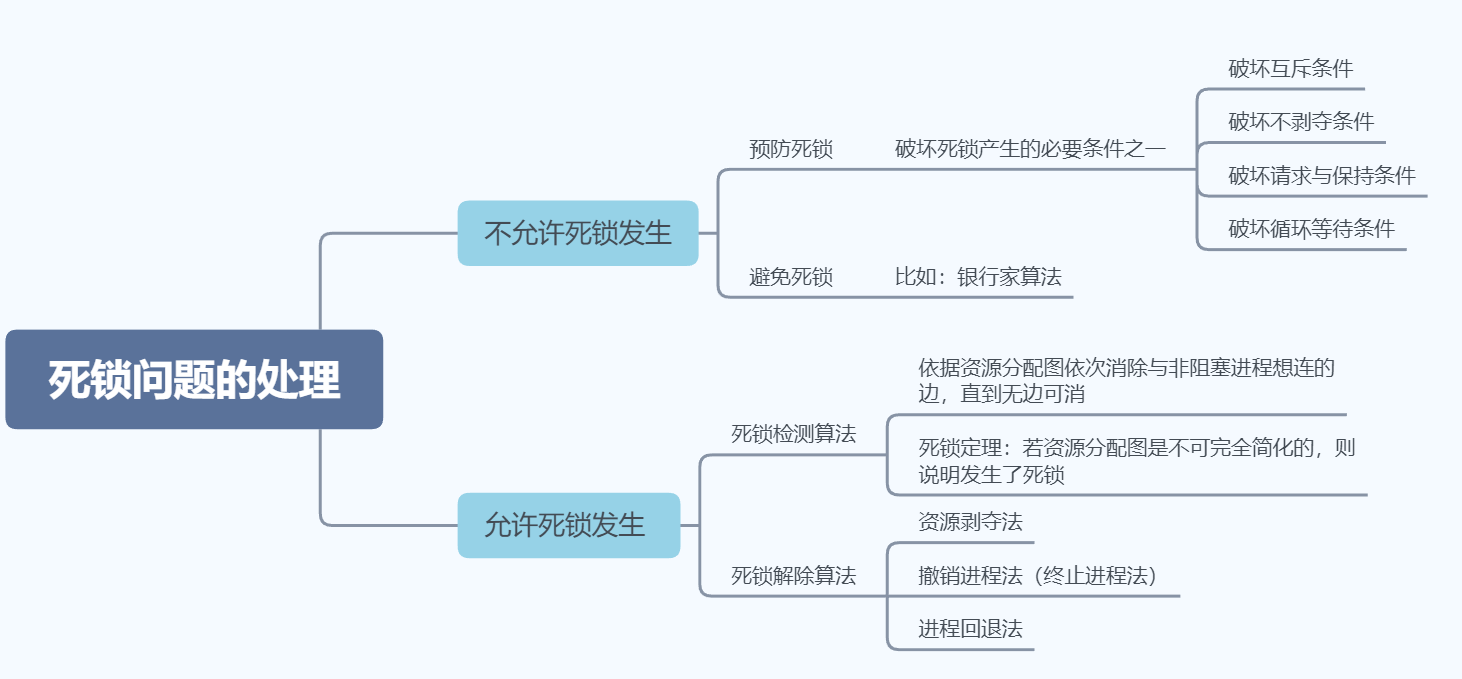
死锁的预防
死锁的预防是保证系统不进入死锁状态的一种策略。它的基本思想是要求进程申请资源时遵循某种协议,从而打破产生死锁的四个必要条件中的一个或几个,保证系统不会进入死锁状态。
-
破坏互斥条件。即允许进程同时访问某些资源。但是,有的资源是不允许被同时访问的,像打印机等等,这是由资源本身的属性所决定的。所以,这种办法并无实用价值。
-
破坏不可剥夺条件。即允许进程强行从占有者那里夺取某些资源。就是说,当一个进程已占有了某些资源,它又申请新的资源,但不能立即被满足时,它必须释放所占有的全部资源,以后再重新申请。它所释放的资源可以分配给其它进程。这就相当于该进程占有的资源被隐蔽地强占了。这种预防死锁的方法实现起来困难,会降低系统性能。
-
破坏请求与保持条件。可以实行资源预先分配策略。即进程在运行前一次性地向系统申请它所需要的全部资源。如果某个进程所需的全部资源得不到满足,则不分配任何资源,此进程暂不运行。只有当系统能够满足当前进程的全部资源需求时,才一次性地将所申请的资源全部分配给该进程。由于运行的进程已占有了它所需的全部资源,所以不会发生占有资源又申请资源的现象,因此不会发生死锁。但是,这种策略也有如下缺点:
(1)在许多情况下,一个进程在执行之前不可能知道它所需要的全部资源。这是由于进程在执行时是动态的,不可预测的;
(2)资源利用率低。无论所分资源何时用到,一个进程只有在占有所需的全部资源后才能执行。即使有些资源最后才被该进程用到一次,但该进程在生存期间却一直占有它们,造成长期占着不用的状况。这显然是一种极大的资源浪费;
(3)降低了进程的并发性。因为资源有限,又加上存在浪费,能分配到所需全部资源的进程个数就必然少了。 -
破坏循环等待条件,实行资源有序分配策略。采用这种策略,即把资源事先分类编号,按号分配,使进程在申请,占用资源时不会形成环路。所有进程对资源的请求必须严格按资源序号递增的顺序提出。进程占用了小号资源,才能申请大号资源,就不会产生环路,从而预防了死锁。这种策略与前面的策略相比,资源的利用率和系统吞吐量都有很大提高,但是也存在以下缺点:
(1)限制了进程对资源的请求,同时给系统中所有资源合理编号也是件困难事,并增加了系统开销;
(2)为了遵循按编号申请的次序,暂不使用的资源也需要提前申请,从而增加了进程对资源的占用时间。
死锁的避免
上面我们讲到的死锁预防是排除死锁的静态策略,它使产生死锁的四个必要条件不能同时具备,从而对进程申请资源的活动加以限制,以保证死锁不会发生。下面我们介绍排除死锁的动态策略--死锁的避免,它不限制进程有关申请资源的命令,而是对进程所发出的每一个申请资源命令加以动态地检查,并根据检查结果决定是否进行资源分配。就是说,在资源分配过程中若预测有发生死锁的可能性,则加以避免。这种方法的关键是确定资源分配的安全性。
1.安全序列
我们首先引入安全序列的定义:所谓系统是安全的,是指系统中的所有进程能够按照某一种次序分配资源,并且依次地运行完毕,这种进程序列{P1,P2,...,Pn}就是安全序列。如果存在这样一个安全序列,则系统是安全的;如果系统不存在这样一个安全序列,则系统是不安全的。
安全序列{P1,P2,...,Pn}是这样组成的:若对于每一个进程Pi,它需要的附加资源可以被系统中当前可用资源加上所有进程Pj当前占有资源之和所满足,则{P1,P2,...,Pn}为一个安全序列,这时系统处于安全状态,不会进入死锁状态。
虽然存在安全序列时一定不会有死锁发生,但是系统进入不安全状态(四个死锁的必要条件同时发生)也未必会产生死锁。当然,产生死锁后,系统一定处于不安全状态。
2.银行家算法
这是一个著名的避免死锁的算法,是由Dijstra首先提出来并加以解决的。
背景知识
一个银行家如何将一定数目的资金安全地借给若干个客户,使这些客户既能借到钱完成要干的事,同时银行家又能收回全部资金而不至于破产,这就是银行家问题。这个问题同操作系统中资源分配问题十分相似:银行家就像一个操作系统,客户就像运行的进程,银行家的资金就是系统的资源。
问题的描述
一个银行家拥有一定数量的资金,有若干个客户要贷款。每个客户须在一开始就声明他所需贷款的总额。若该客户贷款总额不超过银行家的资金总数,银行家可以接收客户的要求。客户贷款是以每次一个资金单位(如1万RMB等)的方式进行的,客户在借满所需的全部单位款额之前可能会等待,但银行家须保证这种等待是有限的,可完成的。
银行家算法允许死锁必要条件中的互斥条件,占有且申请条件,不可抢占条件的存在,这样,它与预防死锁的几种方法相比较,限制条件少了,资源利用程度提高了。
这是该算法的优点。其缺点是:
〈1〉这个算法要求客户数保持固定不变,这在多道程序系统中是难以做到的。
〈2〉这个算法保证所有客户在有限的时间内得到满足,但实时客户要求快速响应,所以要考虑这个因素。
〈3〉由于要寻找一个安全序列,实际上增加了系统的开销。
死锁的检测与恢复
一般来说,由于操作系统有并发,共享以及随机性等特点,通过预防和避免的手段达到排除死锁的目的是很困难的。这需要较大的系统开销,而且不能充分利用资源。为此,一种简便的方法是系统为进程分配资源时,不采取任何限制性措施,但是提供了检测和解脱死锁的手段:能发现死锁并从死锁状态中恢复出来。因此,在实际的操作系统中往往采用死锁的检测与恢复方法来排除死锁。常利用资源分配图、进程等待图来协助这种检测。
死锁检测与恢复是指系统设有专门的机构,当死锁发生时,该机构能够检测到死锁发生的位置和原因,并能通过外力破坏死锁发生的必要条件,从而使得并发进程从死锁状态中恢复出来。一旦在死锁检测时发现了死锁,就要消除死锁,使系统从死锁状态中恢复过来。
-
最简单,最常用的方法就是进行系统的重新启动,不过这种方法代价很大,它意味着在这之前所有的进程已经完成的计算工作都将付之东流,包括参与死锁的那些进程,以及未参与死锁的进程。
-
撤消进程,剥夺资源。终止参与死锁的进程,收回它们占有的资源,从而解除死锁。这时又分两种情况:一次性撤消参与死锁的全部进程,剥夺全部资源;或者逐步撤消参与死锁的进程,逐步收回死锁进程占有的资源。一般来说,选择逐步撤消的进程时要按照一定的原则进行,目的是撤消那些代价最小的进程,比如按进程的优先级确定进程的代价;考虑进程运行时的代价和与此进程相关的外部作业的代价等因素。
此外,还有进程回退策略,即让参与死锁的进程回退到没有发生死锁前某一点处,并由此点处继续执行,以求再次执行时不再发生死锁。虽然这是个较理想的办法,但是操作起来系统开销极大,要有堆栈这样的机构记录进程的每一步变化,以便今后的回退,有时这是无法做到的。
本文来自博客园,作者:BingeCome,转载请注明原文链接:https://www.cnblogs.com/bingeblog/p/17199539.html
